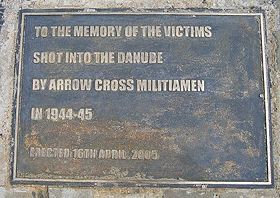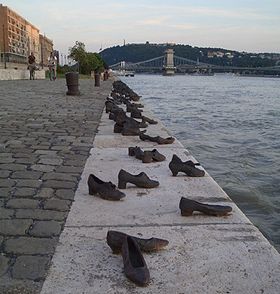
Shoes on the Danube Promenade
Encyclopedia

Can Togay
Can Togay , also known as Can Togay János at times, is a Hungarian film director, screenwriter, actor, poet, producer, cultural manager and cultural diplomate.-Biography:...
on the bank of the Danube River in Budapest
Budapest
Budapest is the capital of Hungary. As the largest city of Hungary, it is the country's principal political, cultural, commercial, industrial, and transportation centre. In 2011, Budapest had 1,733,685 inhabitants, down from its 1989 peak of 2,113,645 due to suburbanization. The Budapest Commuter...
. It honors the Jews who fell victim to fascist Arrow Cross
Arrow Cross Party
The Arrow Cross Party was a national socialist party led by Ferenc Szálasi, which led in Hungary a government known as the Government of National Unity from October 15, 1944 to 28 March 1945...
militiamen in Budapest during World War II
World War II
World War II, or the Second World War , was a global conflict lasting from 1939 to 1945, involving most of the world's nations—including all of the great powers—eventually forming two opposing military alliances: the Allies and the Axis...
, and represents their shoes left behind on the bank when they fell into the river after being shot.
The memorial

Pest (city)
Pest is the eastern, mostly flat part of Budapest, Hungary, comprising about two thirds of the city's territory. It is divided from Buda, the other part of Budapest, by the Danube River. Among its most notable parts are the Inner City, including the Hungarian Parliament, Heroes' Square and...
side of the Danube Promenade
Danube Promenade
The Danube Promenade is located on the Pest side of Budapest, Hungary. On the bank of the Danube, this promenade extends from the Széchenyi Chain Bridge to the Erzsébet Bridge.- History :...
in line with where Zoltan Street would meet the Danube if it continued on that far, about 300 metres (984.3 ft) south of the Hungarian Parliament
Hungarian Parliament Building
The Hungarian Parliament Building is the seat of the National Assembly of Hungary, one of Europe's oldest legislative buildings, a notable landmark of Hungary and a popular tourist destination of Budapest. It lies in Lajos Kossuth Square, on the bank of the Danube, in Budapest...
and near the Hungarian Academy of Sciences
Hungarian Academy of Sciences
The Hungarian Academy of Sciences is the most important and prestigious learned society of Hungary. Its seat is at the bank of the Danube in Budapest.-History:...
.
- "A Cipők a Duna-parton elnevezésű kompozíció a nyilasterror idején Dunába lőtt embereknek állít emléket. a szobrászművész hatvan pár korhű lábbelit formált meg vasból. A parti szegély terméskövére erősített cipok mögött negyven méter hosszúságú, hetven centiméter magas kőpad húzódik. Az emlékhely három pontján öntöttvas táblákon magyarul, angolul és héberül olvasható a felirat: "A nyilaskeresztes fegyveresek által Dunába lőtt áldozatok emlékére állíttatott 2005. április 16-án". forrás: MTI 2005. április 16., szombat
Translation: "The composition entitled 'Shoes on the Danube Bank' gives remembrance to the people shot into the Danube during the time of the Arrow Cross terror. The sculptor created sixty pairs of period-appropriate shoes out of iron. The shoes are attached to the stone embankment, and behind them lies a 40 meter long, 70 cm high stone bench. At three points are cast iron signs, with the following text in Hungarian, English, and Hebrew: "To the memory of the victims shot into the Danube by Arrow Cross militiamen in 1944–45. Erected 16 April 2005." (Source: MTI, Saturday, April 16, 2005.)
- Népszabadság Online, 2005. április 15. 14:25 "Holokauszt-emlékművet avatnak szombaton, a holokauszt áldozatainak emléknapján Budapesten. A hatvan pár, öntöttvasból mintázott korhű cipő a nyilasterror idején Dunába lőtt embereknek állít emléket a Roosevelt tér és a Kossuth tér közötti szakaszon."
Translation: "A holocaust memorial will be dedicated on Saturday, the holocaust victim memorial day, in Budapest. Sixty pairs of cast iron shoes, cast in the styles of the 40's, stand in remembrance of the people shot into the Danube during the Arrow Cross terror. The memorial lies on the riverbank between Roosevelt square and Kossuth square." (source: Népszabadság Online, April 15, 2005.)
January 1945
During World War II, Raoul WallenbergRaoul Wallenberg
Raoul Wallenberg was a Swedish businessman, diplomat and humanitarian. He is widely celebrated for his successful efforts to rescue thousands of Jews in Nazi-occupied Hungary from the Holocaust, during the later stages of World War II...
and 250 coworkers were working around the clock to save the Jewish population from being sent to Nazi concentration camps; this figure later rose to approximately 400. Lars
Lars Ernster
Lars Ernster was a professor of biochemistry, and a member of the Board of the Nobel Foundation- Biography :Lars Ernster was born in Hungary and came to Sweden 1946. He played a prominent role in the scientific community. He took his Ph.D. degree at the Stockholm University in 1956...
and Edith Ernster, Jacob Steiner
Jacob Steiner
Jacob Steiner is a professor at Hebrew University of Jerusalem, and a researcher of the physiology of the senses.- Academic positions :*Lecturer 1965*Senior lecturer 1974*Associate professor 1979*Emeritus 1996...
, and many others were housed at the Swedish Embassy in Budapest on Üllői Street 2-4 and 32 other buildings throughout the city that Wallenberg had rented and then declared as extraterritorial to try to safeguard the residents.
On the night of January 8, 1945, all of the inhabitants of the building on Üllöi Street were rounded up and dragged away to the banks of the Danube by an Arrow Cross execution brigade. At midnight, Karoly Szabo
Károly Szabó
Károly Szabó was an employee of the Swedish Embassy in Budapest from 1944 to 1945. He was a supporter of Raoul Wallenberg and had a significant role in making contact with the representatives of the Hungarian police and other state officials...
and 20 policemen with drawn bayonet
Bayonet
A bayonet is a knife, dagger, sword, or spike-shaped weapon designed to fit in, on, over or underneath the muzzle of a rifle, musket or similar weapon, effectively turning the gun into a spear...
s broke into the Arrow Cross house and rescued everyone there (see also front page of 1947 newspaper below).http://www.spacetime-sensor.de/wallenberg.htm Among those saved were Lars Ernster, who fled to Sweden
Sweden
Sweden , officially the Kingdom of Sweden , is a Nordic country on the Scandinavian Peninsula in Northern Europe. Sweden borders with Norway and Finland and is connected to Denmark by a bridge-tunnel across the Öresund....
and became a member of the board of the Nobel Foundation
Nobel Foundation
The Nobel Foundation is a private institution founded on 29 June 1900 to manage the finances and administration of the Nobel Prizes. The Foundation is based on the last will of Alfred Nobel, the inventor of dynamite....
from 1977 to 1988, and Jacob Steiner, who fled to Israel
Israel
The State of Israel is a parliamentary republic located in the Middle East, along the eastern shore of the Mediterranean Sea...
and became a professor at the Hebrew University of Jerusalem
Hebrew University of Jerusalem
The Hebrew University of Jerusalem ; ; abbreviated HUJI) is Israel's second-oldest university, after the Technion – Israel Institute of Technology. The Hebrew University has three campuses in Jerusalem and one in Rehovot. The world's largest Jewish studies library is located on its Edmond J...
. Steiner's father had been shot dead by Arrow Cross militiamen on December 25, 1944, falling into the Danube. His father had been an officer in World War I
World War I
World War I , which was predominantly called the World War or the Great War from its occurrence until 1939, and the First World War or World War I thereafter, was a major war centred in Europe that began on 28 July 1914 and lasted until 11 November 1918...
and spent four years as a prisoner of war
Prisoner of war
A prisoner of war or enemy prisoner of war is a person, whether civilian or combatant, who is held in custody by an enemy power during or immediately after an armed conflict...
in Russia
Russia
Russia or , officially known as both Russia and the Russian Federation , is a country in northern Eurasia. It is a federal semi-presidential republic, comprising 83 federal subjects...
.
Dr. Erwin K. Koranyi, psychiatrist in Ottawa, wrote about the night of January 8, 1945 in his Dreams and Tears: Chronicle of a Life in 2006, "in our group, I saw Lajos Stoeckler" and "The police holding their guns at the Arrowcross cutthroats. One of the high-ranking police officers was Pal Szalai
Pál Szalai
Pál Szalai also spelled Pál Szalay and anglicized as Paul Sterling was a high ranking member of the Budapest police force and the Hungarian Arrow Cross Party during World War II....
, with whom Raoul Wallenberg used to deal. Another police officer in his leather coat was Karoly Szabo
Károly Szabó
Károly Szabó was an employee of the Swedish Embassy in Budapest from 1944 to 1945. He was a supporter of Raoul Wallenberg and had a significant role in making contact with the representatives of the Hungarian police and other state officials...
."
Pal Szalai was honored as Righteous among the Nations
Righteous Among the Nations
Righteous among the Nations of the world's nations"), also translated as Righteous Gentiles is an honorific used by the State of Israel to describe non-Jews who risked their lives during the Holocaust to save Jews from extermination by the Nazis....
on April 7, 2009.
Map
- On Google MapsGoogle MapsGoogle Maps is a web mapping service application and technology provided by Google, free , that powers many map-based services, including the Google Maps website, Google Ride Finder, Google Transit, and maps embedded on third-party websites via the Google Maps API...
— the memorial is at the top of the map, near Steindl Imre utca, Danube bank http://maps.google.de/maps?ie=UTF8&z=17&ll=47.501605,19.047096&spn=0.00482,0.010042&t=h&om=1 - Danube bank near view: http://maps.google.de/maps?ie=UTF8&om=1&z=18&ll=47.502185,19.046173&spn=0.00241,0.005021&t=h Memorial is on the top of the map, on the bottom Hungarian Academy of SciencesHungarian Academy of SciencesThe Hungarian Academy of Sciences is the most important and prestigious learned society of Hungary. Its seat is at the bank of the Danube in Budapest.-History:...
- Map on Gyula Pauers website http://www.pauergyula.hu/cipok/terkep.htm
Media
- Photographs on Gyula Pauers website http://www.pauergyula.hu/cipok/galeria1.htm
- Film — Memorial to the victims http://www.pauergyula.hu/cipok/UntitledFrame-6.htm#
External links
- Gyula Pauer site
- Jewish Budapest site
- Edith Ernster remembers http://www.raoulwallenberg.org/who/hero.html" In the darkest days of 1944, the Swedish protective passport even provided some humor in the midst of despair. Edith Ernester, who lived through that time, recalls: "It seemed so strange - this country of super-aryans, the Swedes, taking us under their wings. Often, when an Orthodox Jew went by, in his hat, beard and sidelocks, we'd say, 'Look, there goes another Swede.' A special department was created in the Swedish embassy in Budapest with Wallenberg as its head. It was staffed primarily with Jewish volunteers. Initially, there were 250 workers; later, he had about 400 people working around the clock. Wallenberg seemed to sleep no more than an hour or two a night, and then it was wherever he happened to be working. He was everywhere."
- Document about January 8. 1945. in Budapest Archives (Hungarian) http://www.spacetime-sensor.de/wallenberg-h.htm
- Other documents about January 8. 1945. (English) http://www.spacetime-sensor.de/wallenberg.htm
- Photographs of the shoes Szoborlap.hu

